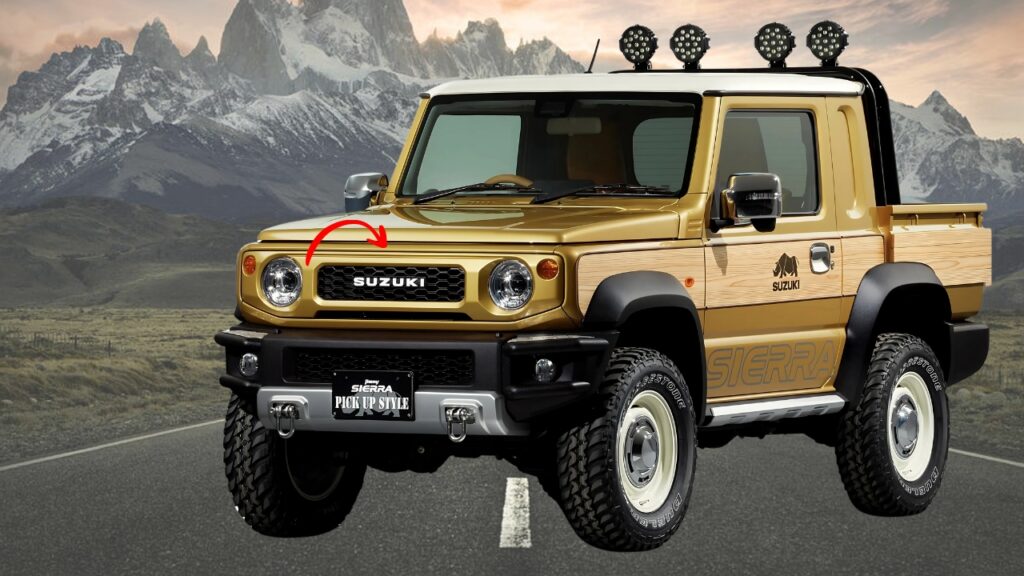
The idea of a Suzuki Jimny ute has got Australian car enthusiasts buzzing, and it’s not hard to see why. Michael Pachota, Suzuki Australia’s general manager, recently shared his enthusiasm for expanding the popular Jimny lineup beyond its current wagon-only offerings.
“A Jimny ute would be awesome in Australia. A Jimny anything is awesome in Australia,” Pachota told reporters during the launch of Suzuki’s new Fronx Hybrid. His comments have sparked conversations across the automotive community about whether Australia needs another small pickup truck.
The timing couldn’t be better. The Jimny is currently Suzuki’s best-selling model in Australia, with both three-door and five-door XL variants consistently growing in popularity. This success suggests there’s definitely an appetite for more Jimny variants.

What Makes a Jimny Ute Different?
Unlike the massive pickups dominating Australian roads, a potential Jimny ute would offer something completely different. We’re talking about a vehicle that prioritizes maneuverability over raw hauling capacity.
The current three-door Jimny measures just 3,480mm in length – that’s nearly two meters shorter than a Ford Ranger. Even the five-door version stretches to only 3,820mm, making it incredibly compact by today’s standards.
The Perfect Size for Real-World Applications
Agricultural Applications
Pachota highlighted one specific use case that really demonstrates the Jimny’s potential. Speaking from Victoria’s Goulburn Valley wine region, he pointed out how perfectly a compact ute would fit between vineyard rows.
“You can just see the width of those vineyard lines. A Jimny ute would fit down that line perfectly,” he explained. This isn’t just theoretical – it’s about solving real problems that larger utes simply can’t address.
Urban and Suburban Benefits
Think about tight city parking, narrow laneways, or residential construction sites where space is premium. A Jimny ute could navigate spaces where traditional pickups fear to tread, while still offering the utility that makes utes so popular.
Suzuki’s Commercial Vehicle Heritage
| Historic Suzuki Ute Models | Years Available |
|---|---|
| Suzuki Mighty Boy | 1980s |
| Suzuki Stockman (Soft Top) | 1970s-1980s |
| Suzuki Caribian Sporty | 1990s |
| Holden Drover (SJ40 pickup) | 1980s |
This isn’t Suzuki’s first rodeo with compact commercial vehicles. The brand has a rich history of small, practical workhorses that served specific market needs. The original Suzuki Stockman, for instance, was essentially the first-generation Jimny in pickup form.
Learning from New Zealand
Interestingly, our neighbors across the Tasman have been enjoying Jimny utes since 2020, thanks to aftermarket conversion programs. This proves there’s both demand and feasibility for such vehicles in the region.
Market Reality Check
Competition and Positioning
Australia’s ute market is dominated by heavy-hitters like the Toyota HiLux and Ford Ranger. These vehicles excel at towing boats and carrying heavy loads, but they’re overkill for many everyday tasks.
A Jimny ute wouldn’t compete directly with these giants. Instead, it would create its own niche – serving customers who need pickup versatility in a package that actually fits their lifestyle and workspace constraints.
Manufacturing Considerations
The current fourth-generation Jimny platform doesn’t include any commercial variants in global production. However, Suzuki has shown interest in expanding the range, particularly given the success of the passenger models.
Previous Jimny generations offered much more variety, including canvas tops, pickups, and even tiny cab-chassis variants. This historical precedent suggests the engineering challenges aren’t insurmountable.
What This Means for Australian Buyers
The enthusiasm from Suzuki Australia’s leadership is encouraging, but Pachota was careful to manage expectations. “Suzuki keeps their product development fairly close to their chest,” he admitted, while expressing hope that the Japanese headquarters might consider such expansion.
For potential buyers, this represents an interesting possibility. A Jimny ute could offer:
- Exceptional maneuverability in tight spaces
- Lower running costs than full-size utes
- Suzuki’s reputation for reliability
- Unique style that stands out from mainstream pickups
The conversation around a Jimny ute reflects broader changes in how Australians think about vehicles. Not everyone needs to haul three-tonne trailers or navigate remote mining sites. Many people simply want something practical, reliable, and appropriately sized for their actual needs.
Whether Suzuki will ultimately greenlight a Jimny ute for Australia remains to be seen. But the enthusiasm from local management, combined with the model’s current success, suggests this idea deserves serious consideration.
Frequently Asked Questions
Q: When might a Suzuki Jimny ute become available in Australia?
A: No timeline has been announced. Suzuki Australia is expressing interest, but any decision would come from the Japanese headquarters.
Q: How much would a Jimny ute likely cost?
A: Pricing hasn’t been discussed, but it would likely sit between current Jimny wagon prices and entry-level traditional utes.
Q: Would a Jimny ute have serious off-road capability?
A: Given the current Jimny’s impressive 4WD credentials, a ute version would likely maintain similar off-road competence in a more practical package.
2025 Volkswagen GTI First Drive Review: Fun, Fast, and Refined